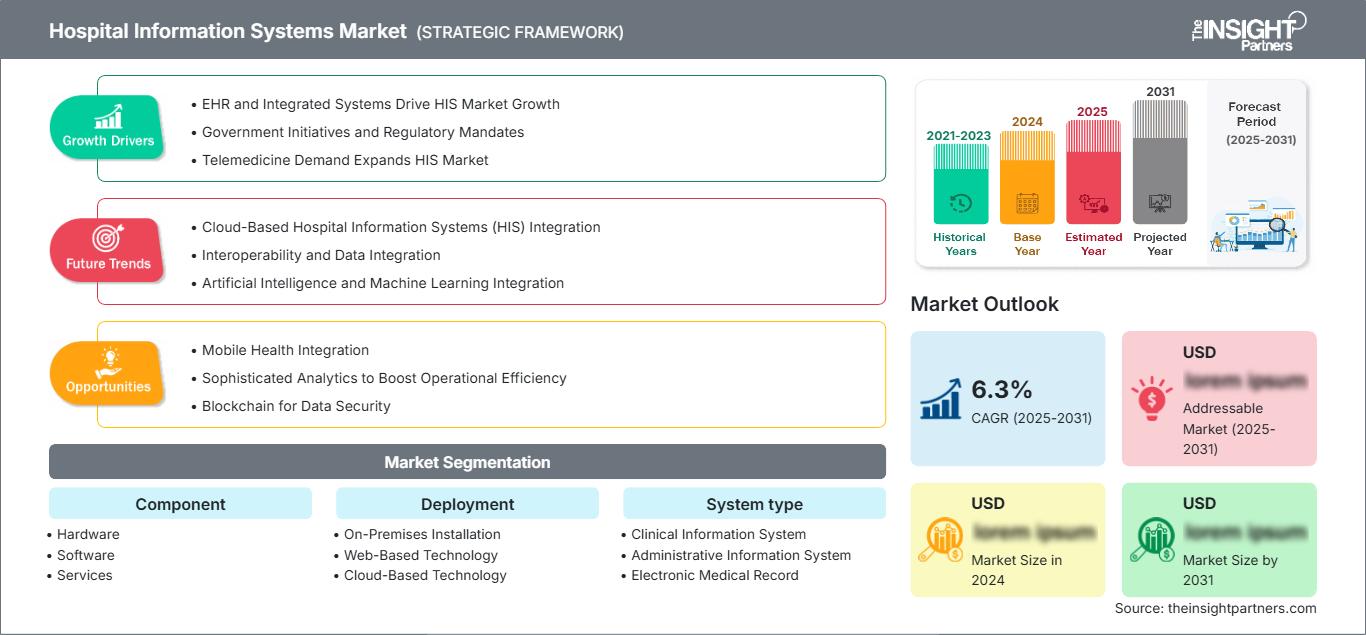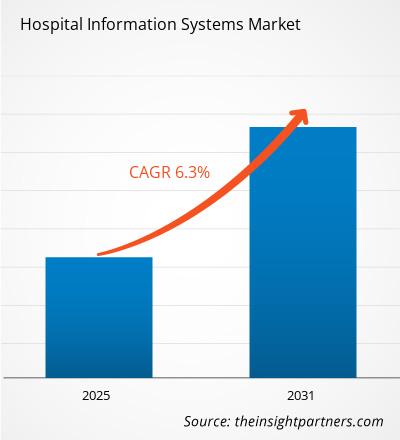页面已更新 :
Jan 2025
预计到2031年,医院信息系统市场规模将达到2.5005亿美元。预计2025年至2031年期间,该市场将以11.8%的复合年增长率增长。
医院信息系统市场报告涵盖了全球和区域市场概况,并按组件、部署方式、系统类型和最终用户进行了细分分析。该市场研究报告还介绍了主要参与者所采取的商业策略。
报告目的
The Insight Partners发布的《医院信息系统市场报告》旨在描述医院信息系统市场的现状和未来增长趋势,以及主要驱动因素、挑战和机遇。该报告将为各类商业利益相关者提供参考,例如:
- 技术提供商/制造商:了解不断变化的市场动态和潜在的增长机会,从而能够做出明智的战略决策。
- 投资者:对市场增长率、市场财务预测以及整个价值链中存在的机会进行全面的趋势分析。
- 监管机构:监管市场政策和执法活动,旨在最大限度地减少滥用行为,维护投资者信任和信心,维护市场的诚信和稳定。
医院信息系统市场细分组成部分
- 硬件
- 软件
- 服务
部署
- 本地安装
- 基于网络的技术
- 云技术
系统类型
- 临床信息系统
- 行政信息系统
- 电子病历
- 实验室信息系统
- 放射科信息系统
- 其他的
最终用户
- 医院
- 保险公司
- 其他的
根据您的需求定制此报告
您可以免费获得任何报告的定制服务,包括本报告的部分内容、国家/地区层面的分析、Excel 数据包,以及面向初创企业和高校的优惠折扣。
医院信息系统市场:战略洞察

- 获取本报告的主要市场趋势。这份免费样品将包含数据分析,内容涵盖市场趋势、估算和预测等。
医院信息系统市场增长驱动因素
- 电子病历和集成系统推动医院信息系统市场增长:电子病历 (EHR) 和集成系统的普及应用显著推动了医院信息系统市场的增长。医疗机构正努力通过先进技术改善患者护理并优化运营流程。这导致市场对高效医院管理平台的需求不断增长,从而对医院信息系统市场份额产生重大影响,并促进了技术投资。
- 政府举措和监管要求:世界各国政府都在大力投资医疗数字化进程,并强制实施医院信息系统(HIS),以期提供更优质的医疗服务。这些举措,例如为实施HIS提供激励措施,有助于扩大医院信息系统市场规模。对更完善的患者管理和信息处理的需求,推动了发达地区和发展中地区HIS基础设施的增长。
- 远程医疗需求推动医院信息系统市场扩张:对远程医疗和其他远程医疗服务日益增长的需求,催生了对集成化、可互操作的医院信息系统的需求。大多数趋势在疫情后获得了显著发展,因此将成为推动医院信息系统市场增长的重要因素。这种趋势与医院信息系统平台完美契合,能够更好地同步数据,并推动全球医院信息系统市场的未来增长。
医院信息系统市场未来趋势
- 基于云的医院信息系统 (HIS) 集成:云计算技术通过实现高效的数据管理、远程访问和可扩展性,为医院信息系统市场带来了变革。它吸引着那些寻求灵活方案以满足其成本削减需求的医疗机构。医院信息系统市场正迅速向云平台转型,以优化工作流程、降低 IT 基础设施成本并实时访问患者数据,尤其是在远程医疗领域。正如近期对医院信息系统市场的分析所表明的那样,这一趋势正在推动市场增长,主要原因是医疗服务提供商越来越多地采用数字化转型。
- 互操作性和数据集成:医疗保健生态系统的扩展需要跨该领域现有各种平台实现无缝共享的数据流。医院信息系统市场概述指出,对将电子健康记录 (EHR) 与其他技术(例如可穿戴设备和诊断工具)集成的此类系统的需求正在不断增长。增强的互操作性不仅可以改善患者预后,还能确保做出更明智的临床决策。医院信息系统的主要市场参与者正在开发解决方案,以简化数据交换,满足行业日益增长的互联互通和全方位护理管理需求。
- 人工智能和机器学习的融合:随着人工智能 (AI) 和机器学习 (ML) 的出现,医院信息系统市场正迅速发展成为一项必不可少的需求。预测分析和决策支持系统有助于高效分析患者数据并识别早期诊断模式,从而提供最佳治疗方案,而这些方案的制定离不开人工智能驱动的医院信息系统解决方案的支持。这种转变正在改变医院信息系统市场的趋势,使其朝着个性化医疗的方向发展。医院信息系统市场分析清晰地表明,该市场的主要参与者正在加大对人工智能的投资,以确保医疗保健不仅有效,而且安全。
医院信息系统市场机遇
- 移动医疗整合:随着移动医疗应用的日益普及,移动医疗与医院系统的整合在医院信息系统市场中蕴藏着巨大的发展机遇。通过智能手机提供健康记录访问、预约服务和远程患者监测等功能,医院能够提升患者参与度和就医体验。以患者为中心的医疗服务以及医患之间的顺畅沟通,极有可能进一步推动移动医疗整合的实施,从而使先行者在竞争中脱颖而出。
- 先进分析助力提升运营效率:医院将越来越重视先进分析技术,从优化资源配置的先进预测模型到降低成本和提高工作流程效率。医院信息系统市场动态进一步表明,能够进行预测分析并实时深入了解医院运营状况的解决方案,将彻底改变决策格局。未来几年,用于预测患者数量并优化人员配备、库存和物流的分析技术,将成为医院信息系统的关键增长领域。
- 区块链助力数据安全:区块链技术有望为医院信息系统市场带来革命性的变革,显著提升数据安全性。它具有去中心化和防篡改的特性,能够永久存储患者记录,同时有效应对医疗保健数据隐私方面日益严峻的安全挑战。随着区块链技术逐渐成为医院确保安全共享敏感健康信息的标准做法,专注于区块链应用开发的公司将拥有广阔的发展空间,在这个不断增长的市场中占据一席之地。
医院信息系统市场区域洞察
The Insight Partners 的分析师对预测期内影响医院信息系统市场的区域趋势和因素进行了详尽的阐述。本节还探讨了北美、欧洲、亚太、中东和非洲以及南美和中美洲等地区的医院信息系统市场细分和地域分布。
医院信息系统市场报告范围
| 报告属性 | 细节 |
|---|---|
| 2024年市场规模 | XX百万美元 |
| 到2031年市场规模 | 2.5005亿美元 |
| 全球复合年增长率(2025-2031年) | 11.8% |
| 史料 | 2021-2023 |
| 预测期 | 2025-2031 |
| 涵盖部分 | 按组件
|
| 覆盖地区和国家 | 北美
|
| 市场领导者和主要公司简介 |
|
医院信息系统市场参与者密度:了解其对业务动态的影响
医院信息系统市场正快速增长,这主要得益于终端用户需求的不断增长,而终端用户需求的增长又源于消费者偏好的转变、技术的进步以及消费者对产品优势认知的提高。随着需求的增长,企业不断拓展产品和服务,持续创新以满足消费者需求,并把握新兴趋势,这些都进一步推动了市场增长。

- 获取医院信息系统市场主要参与者概览
主要卖点
- 全面覆盖:该报告全面分析了医院信息系统市场的产品、服务、类型和最终用户,提供了一个全面的市场概况。
- 专家分析:该报告是根据行业专家和分析师的深入理解编制的。
- 最新信息:该报告涵盖了最新的信息和数据趋势,确保了其与业务的相关性。
- 定制选项:本报告可根据客户的具体需求进行定制,并能恰当地适应业务战略。
因此,这份关于医院信息系统市场的研究报告有助于深入了解和解读行业现状及增长前景。尽管其中可能存在一些合理的担忧,但总体而言,这份报告的优势远大于劣势。
- 历史分析(2 年)、基准年、预测(7 年)及复合年增长率
- PEST和SWOT分析
- 市场规模、价值/数量 - 全球、区域、国家
- 行业和竞争格局
- Excel 数据集
近期报告
相关报告
客户评价
购买理由
- 明智的决策
- 了解市场动态
- 竞争分析
- 客户洞察
- 市场预测
- 风险规避
- 战略规划
- 投资论证
- 识别新兴市场
- 优化营销策略
- 提升运营效率
- 顺应监管趋势
我们的客户































87-673-9708

ISO 9001:2015





 获取免费样品 - 医院信息系统市场
获取免费样品 - 医院信息系统市场